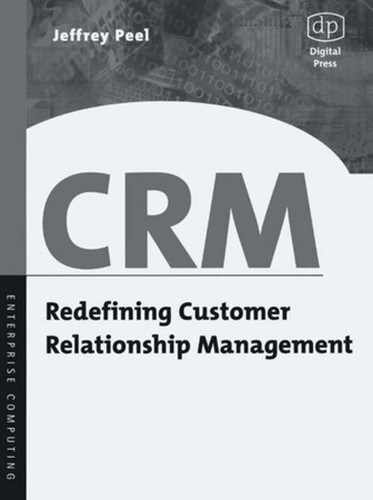
Glossary of CRM-Related Terms 183
responsiveness. SLAs that are set on the basis of customer need are particularly
appropriate. For example, a service organization may define an average hold
time of 10 minutes as a worthy objective. However, the reality from the cus-
tomer perspective is that a 10-minute average performance may translate into
a 40-minute wait period, on average, during peak calling periods, which is
utterly unacceptable.
SMS
Short message service (or often referred-to simply as mobile text messaging).
Text messaging across the mobile network has taken off in Europe in particu-
lar, resulting in significant percentages of mobile phone operator revenue
being accounted for by data services. SMS is a potential CRM vehicle allowing
customers to access their account histories or to obtain alerts via the SMS serv-
ice. Many European banks now offer access to bank account data using
outbound SMS alerts.
SOAP
SOAP is a so-called lightweight protocol for the exchange of information in a
decentralized, distributed environment (i.e., across the Internet or across a
widely distributed corporate intranet). It is an XML-based protocol that con-
sists of three parts: an envelope that defines a framework for describing what is
in a message and how to process it, a set of rules for expressing instances of
application-defined datatypes, and a convention for representing remote pro-
cedure calls and responses. SOAP is emerging as the standard protocol for the
Web services model
(see also
UDDI and Web Services).
Synchronous communications
See
Asynchronous communications
Trouble
ticketing
CRM and support initiatives can be impacted if, in a service organisation
(such as a telecommunications service company), customer-facing staff are
not made aware of service faults. Trouble ticketing can help by allowing cus-

184 Glossary of CRM-Related Terms
tomer service staff to get status reports on service faults and information
regarding affected customers.
UDDI
Here is the definition from the UDDI Community, the body that runs
UDDI.org and is developing a set of open standards for a service registry
(www.UDDI.org).
The Universal Description, Discovery and Integration (UDDI) project is
a sweeping industry initiative. The project creates a platform-
independent, open framework for describing services, discovering busi-
nesses, and integrating business services using the Internet, as well as an
operational registry that is available today.
UDDI is the first truly cross-industry effort driven by all major platform
and software providers, as well as marketplace operators and e-business
leaders. These technology and business pioneers are acting as the initial
catalysts to quickly develop UDDI and related technologies.
The UDDI project takes advantage of WorldWide Web Consortium
(W3C) and Internet Engineering Task Force (IETF) standards such as
Extensible Markup Language (XML), and HTTP and Domain Name
System (DNS) protocols. Additionally, cross platform programming fea-
tures are addressed by adopting early versions of the proposed Simple
Object Access Protocol (SOAP) known as XML Protocol messaging
specifications found at the W3C Web site. The UDDI protocol is the
building block that will enable businesses to quickly, easily and dynami-
cally find and transact with one another using their preferred ap-
plications. Over 220 companies are members of the UDDI community.
VolP
Voice over IP (i.e., synchronous voice communications over the Internet).
The majority of voice calls are currently carried over non-IP-based digital
phone networks. VolP denotes synchronous voice calls conducted over the
Internet using the Internet protocol. Over time, more and more Internet
devices will allow interpersonal voice communications to be conducted on the
Internet, certainly as more and more mobile devices adopt IP-based GPRS or
3G technologies. Therefore, it's likely that in a CRM context we will see the

Glossary of CRM-Related Terms 185
emergence of contact centers supporting voice and text IP-based communica-
tions channels.
Web service
A Web service is an application that resides on the Internet and can be called
as an object or component in a Web-based application. Standards are emerg-
ing for Web services, describing the method by which Web services are carried
over the Internet and can be found using directory services. Many analysts
believe that the Web services model will ultimately replace so-called "hard-
wired" applications as the standard means of providing enterprise-class CRM
services in the future. See also UDDI.
WML
Wireless markup language~the equivalent of HTML in the mobile phone
world. WML allows Internet-based information to be received by a WAP
(wireless application protocol based) mobile phone.
WSDL
Here's the Ariba/IBM/Microsoft definition. "WSDL is an XML format for
describing network services as a set of endpoints operating on messages con-
taining either document-oriented or procedure-oriented information. The
operations and messages are described abstractly, and then bound to a con-
crete network protocol and message format to define an endpoint. Related
concrete endpoints are combined into abstract endpoints (services). WSDL is
extensible to allow description of endpoints and their messages regardless of
what message formats or network protocols are used to communicate."
XML
This is Norman Walsh's definition from XML.com
XML is a markup language for documents containing structured
information.
Structured information contains both content (words, pictures, etc.) and
some indication of what role that content plays (for example, content in a

186 Glossary of CRM-Related Terms
section heading has a different meaning from content in a footnote,
which means something different than content in a figure caption or con-
tent in a database table, etc.). Almost all documents have some structure.
A markup language is a mechanism to identify structures in a docu-
ment. The XML specification defines a standard way to add markup to
documents.
XML, or rather SOAP (a subset of XML) is the backbone or defining pro-
tocol for emerging Web services standards. Many CRM software vendors are
developing applications based on Web services compliant components.
..................Content has been hidden....................
You can't read the all page of ebook, please click here login for view all page.
